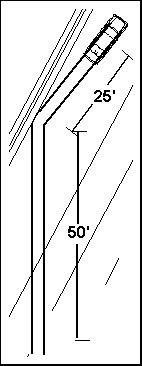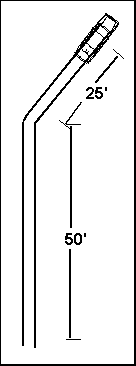
The Traffic Accident Reconstruction Origin -Approach Angles Solution-


The Traffic Accident Reconstruction Origin -Approach Angles Solution-
|

|
A Solution for "What is the Context" By John Allen

Question 1: A car glances off a rigid barrier, skidding 50 feet before the collision and 25 feet after the collision. The coefficient of friction is 0.75 and the grade is negligible. What is the minimum initial speed of the vehicle?
The minimum speed is found from the work done by the car skidding on the roadway. Damage to the car and barrier wall caused by the collision represents work that is undocumented. This is one reason we refer to the estimate as a minimum speed estimate. In this case, a minimum initial speed can be determined from the total skid length of 75 feet as 41 mph (66.1 km/h).



Question 2: The same car has a skid path identical to that in Question 1, including the abrupt change in direction. The car, however, did not hit a barrier. What is the minimum initial speed of the car?
Since no barrier was involved, we can presume that a second vehicle was involved, the evidence of which is not reported. To simplify the discussion, let's refer to that second vehicle as a truck and let's presume that the car was initially travelling north. Again, the minimum speed equation will be employed.
There are combinations of truck mass, speed, and direction that will cause the car to behave as if it had hit a rigid barrier. In such a case, the square of the northward speed lost by the car is just offset by the square of the eastward speed added to the car collision. Let's call this the baseline solution.
If the truck approaches from a more northerly direction, the minimum initial speed of the car would be greater. The square of the northward speed lost by the car would be greater than the square of the eastward speed added to the car.
The interesting scenario occurs when the truck is approaching from a more southerly direction. The truck can add to both the northern speed and eastern speed of the car. In fact, the car may have just come to rest at the end of its purely northern path when it was hit by the truck. The northeasterly skid marks result only from the motion imparted by the truck. In this limiting case, the minimum initial speed is determined using a skid distance of 50 feet rather than 75 feet. The minimum initial speed of the car is then 33.5 mph.


Taking this line of argument even further, the car could have been stopped in the street due to congestion when it was struck in the rear by a bus. After skidding 50 feet north, it was struck from its left rear quarter by the truck. The second collision caused the car to skid 25 feet in a northeasterly direction. In that case, the minimum initial speed of the car is zero.
Then there was this car that was initially backing upů
Question #3: What is different about the collision with the barrier and the collision with the truck?
Unlike the truck, the barrier is unable to strike the car from the rear.
An interesting side issue is whether momentum is conserved during the collision with the barrier. Seemingly it is not. Seemingly only the momentum of the car was changed; there was no corresponding momentum change for a second vehicle.
"Au contraire", retorts Sir Isaac. "Momentum is conserved. It always is. You failed to recognize that the momentum of the earth changed. We can even calculate its deltaV.
The deltaV of the earth is merely the deltaV of the car ratioed by their relative weights. Since the car weighs about 3000 pounds, and since the earth weighs about 12,000,000,000,000,000,000,000,000 pounds, the speed change of the earth is small. It is so small, in fact, that we may presume it to be zero for most calculations. That, however, is only a presumption. I assure you that when the car and the barrier kissed, the earth moved."
John Allen is a Senior Principal Engineer / Scientist at The Boeing Company in Long Beach, California. He is also a part time accident reconstructionist. His email address is john@semiotics.com.
|
Copyright ©
|